During the 1999 conflict over Kosovo, the KLA was seen by the U.K. as terrorist, but was covertly and overtly supported by the Labour government, Mark Curtis reports.
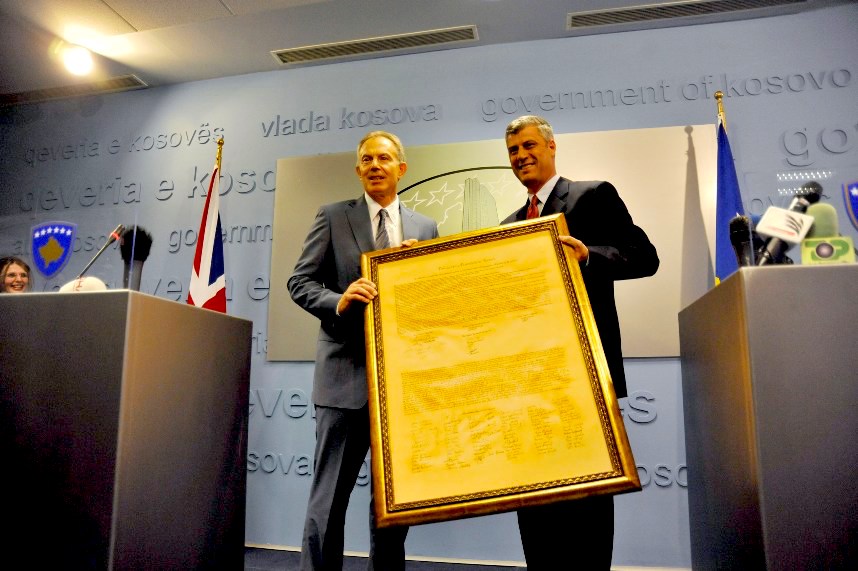
Former KLA leader Hashim Thaçi, on right, with former U.K. Prime Minister Tony Blair with the Declaration of Independence of Kosovo in 2010. (Office of Prime Minister of Kosovo, Public domain, Wikimedia Commons)
By Mark Curtis
Declassified UK
- Blair’s Foreign Secretary Robin Cook was in direct touch with KLA leader Hashim Thaci, now on trial for war crimes, during the Kosovo war
- The U.K. secretly gave military training to the KLA while it had working links to Al-Qaida
- Blair denied in parliament the U.K. was training the KLA
 NATO’s bombing campaign against Slobodan Miloševic’s Yugoslavia in 1999 is routinely presented as an “humanitarian intervention.” Former U.K. Prime Minister Tony Blair has long been praised for coming to the defence of ethnic Albanians in the territory of Kosovo who were subject to increasingly brutal abuses by the Yugoslav army from the end of 1998.
NATO’s bombing campaign against Slobodan Miloševic’s Yugoslavia in 1999 is routinely presented as an “humanitarian intervention.” Former U.K. Prime Minister Tony Blair has long been praised for coming to the defence of ethnic Albanians in the territory of Kosovo who were subject to increasingly brutal abuses by the Yugoslav army from the end of 1998.
The Kosovo Liberation Army fought Yugoslav forces until the 78-day NATO air campaign, begun in March 1999, forced Miloševic’s army from Kosovo. Before and during the war Britain collaborated with the KLA which essentially acted as NATO’s ground forces in Kosovo.
Fourteen years on, the KLA’s former leader, Hashim Thaci, and three other senior members are now on trial charged with war crimes and crimes against humanity, including murder, enforced disappearances, persecution, and torture.
The prosecutor in The Hague alleges that the four formed part of a joint criminal enterprise to control Kosovo by “unlawfully intimidating, mistreating, committing violence against, and removing those deemed to be opponents.”
The victims of these alleged crimes include Serbs, Roma and ethnic Albanians who were considered collaborators with Serbian forces or political opponents of the KLA.
‘Terrorist Group’
The KLA comprised ethnic Albanians committed to securing independence for Kosovo from Yugoslavia and promoting a “Greater Albania” in the sub-region.
The force consisted of a mix of radicalised youths and students, professionals such as teachers and doctors, members of influential families and local rogues. It took to armed struggle and made its military debut in early 1996 by bombing camps housing Serbian refugees from the wars in Croatia and Bosnia and by attacking Yugoslav government officials and police stations.
By mid-1998 the KLA controlled a large segment of Kosovo and had armed and organised thousands of fighters. It was a formidable force on the ground when, amidst a growing civil war, the Yugoslav army launched a brutal full-scale offensive in Kosovo in March 1999.
From its inception, the KLA targeted Serbian and Albanian civilians, especially those considered collaborators with the authorities. Declassified British documents show the chair of the Joint Intelligence Committee, Michael Pakenham, writing in September 1998 that the KLA is “exploiting the plight of civilians, and itself appears to have committed atrocities against Serbs.”
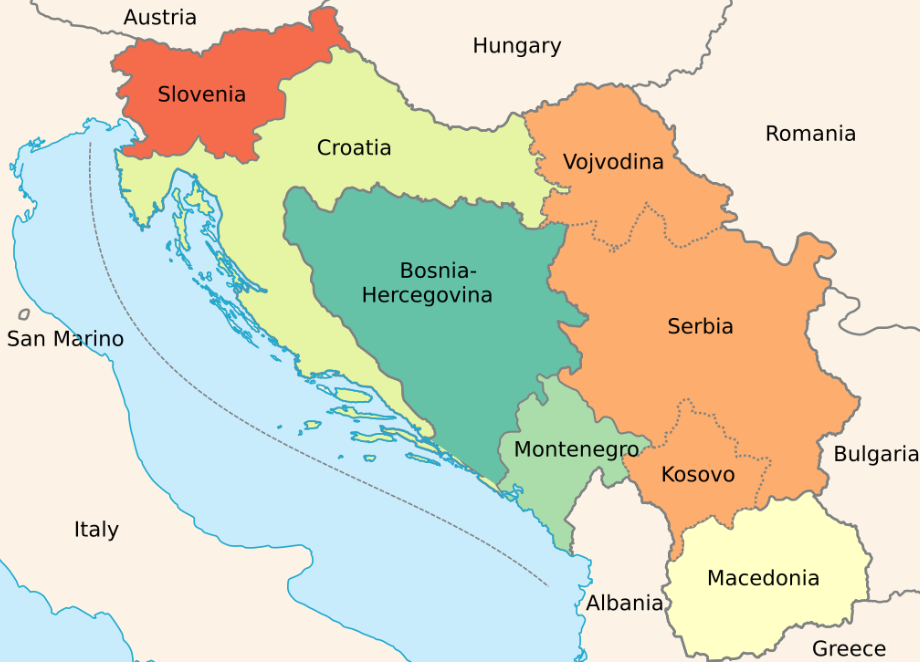
The six Yugoslav republics and the two autonomous provinces between 1945 and 1992. (CC BY-SA 3.0, Wikimedia Commons)
The U.S. and Britain clearly recognised the KLA as a terrorist organisation. In February 1998, the Clinton administration’s special envoy to Kosovo, Robert Gelbard, described the KLA as “without any question a terrorist group.”
Similarly, Foreign Secretary Robin Cook told parliament in March 1998: “We strongly condemn the use of violence for political objectives, including the terrorism of the self-styled Kosovo Liberation Army.”
Indeed, in November 1998, and again in January 1999, Cook said that “most of the killings” in Kosovo recently had been carried out by the KLA, whose activities against ordinary Kosovars were only serving to “prolong their suffering.”
Parliamentary statements by British ministers make clear that they continued to regard the KLA as a terrorist organisation right up to the beginning of the bombing campaign in March 1999.
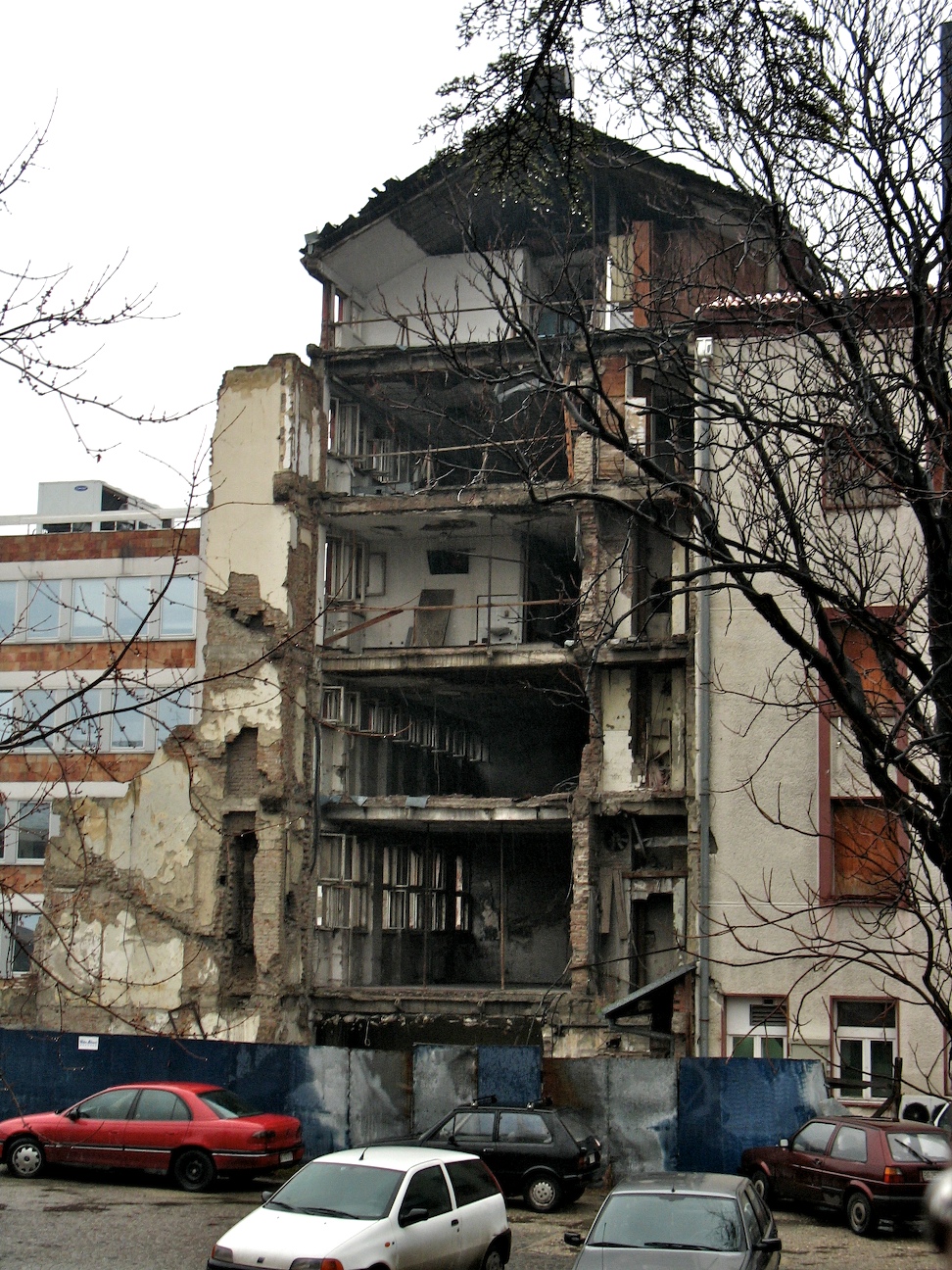
Ruins of the Radio Television of Serbia, destroyed during 1999 NATO bombing in Belgrade, Serbia, former Yugoslavia. (Pino/Flickr/CC BY-SA 2.0, Wikimedia Commons)
“We condemn their violent activities,” said an internal Foreign Office brief about the KLA in August 1998.
Indeed, the files from 1998 clearly show that British officials were concerned that air strikes against Yugoslavia that they were then considering would empower the KLA and its claims to full independence for Kosovo, to which Whitehall was opposed.
British planners even considered military action against the KLA at this time but ruled it out as impractical.
The KLA was also widely known to be involved in heroin trafficking into Britain while MI6 was investigating its links to organised crime. Brian Donnelly, Britain’s ambassador to Yugoslavia, wrote in June 1998: “Some, at least, in the KLA are likely to be the first cousins of the Albanians who are running organised crime and drug running throughout Europe.”
Al-Qaida Connections
The KLA had also developed connections to Al-Qaida. Osama bin Laden reportedly visited Albania and established an operation there in 1994. In the years preceding the NATO bombing campaign, more Al-Qaeda militants moved into Kosovo to support the KLA, financed by sources in Saudi Arabia and the United Arab Emirates.
By late 1998, the head of Albanian intelligence was saying that bin Laden had sent units to fight in Kosovo. Al-Qaeda was said to be helping hundreds of foreign fighters to cross from Albania into Kosovo, including veterans of the militant group Islamic Jihad from Bosnia, Chechnya and Afghanistan, carrying forged passports.
Numerous KLA fighters had trained in Al-Qaida camps in Afghanistan and Albania. One of the “links” between bin Laden and the KLA said to have been identified by U.S. intelligence was “a common staging area in Tropoje, Albania, a centre for Islamic terrorists.”
One KLA unit was led by the brother of Ayman al-Zawahiri, then bin Laden’s right-hand man, according to a senior Interpol official who later gave evidence to the U.S. Congress.
Asked in Parliament in November 1998 about a media article stating that mujahideen fighters had been seen with KLA forces in Kosovo, Robin Cook stated: “I read that report with concern.”
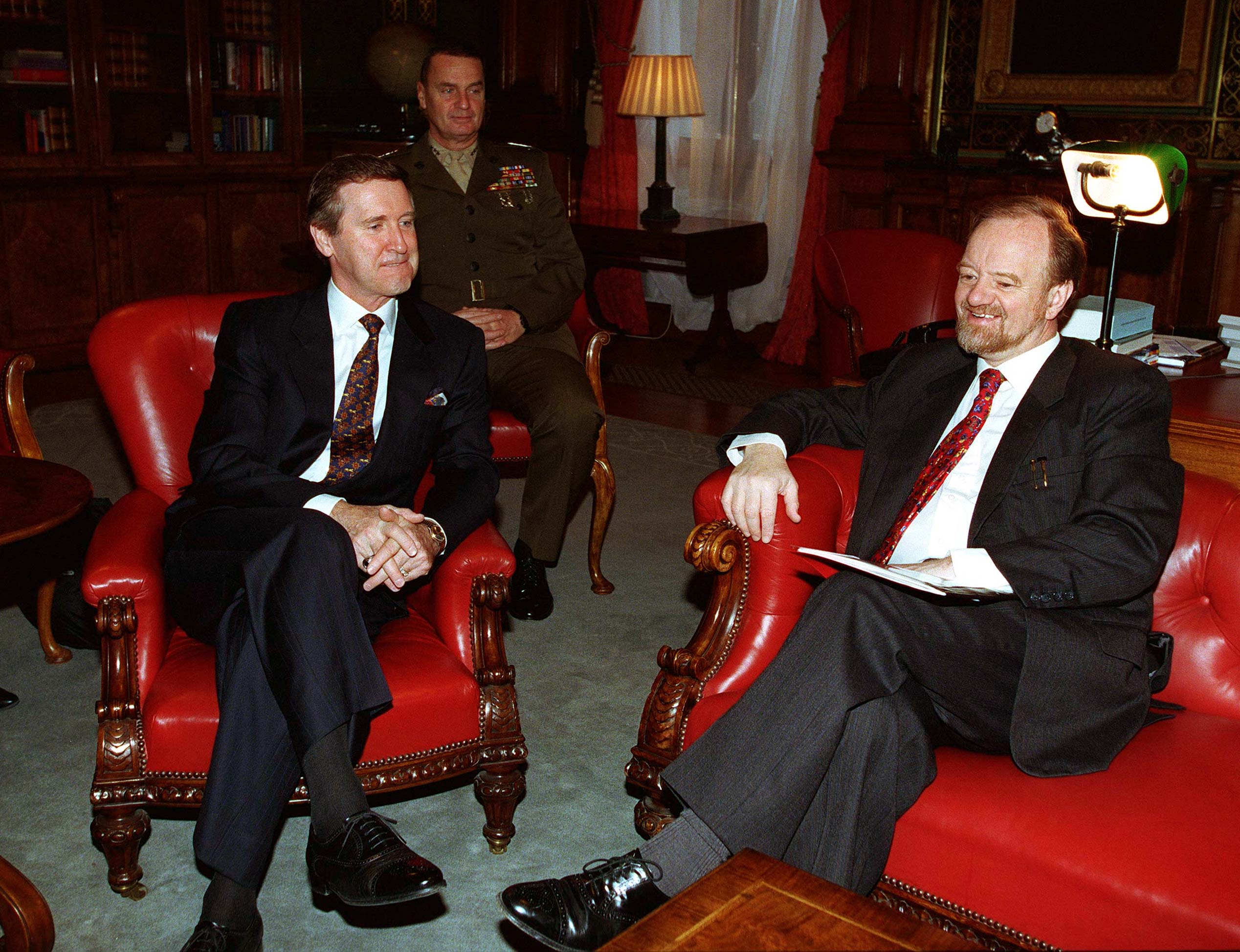
U.K. Foreign Secretary Robin Cook, on right, meeting with U.S. Defense Secretary William Cohen in London on Dec. 4, 1997. (DoD/Helene C. Stikkel)
In March 1999, his deputy, Foreign Minister Tony Lloyd, told the House of Commons that the government was aware of media reports of contacts between Islamic terrorist groups and the KLA but “we have no evidence of systematic involvement.”
The use of the word “systematic” was probably carefully chosen to imply that the government had some knowledge.
At some point in 1996 British intelligence, along with the U.S. and Swiss services, made its first known contact with a senior KLA official in Albania, likely to have been Shaban Shala, a commander who would fight in Kosovo in 1999 and also inside Serbia in 2000.
Formal contacts between the KLA and the U.S. took place in July 1998 when Chris Hill, the U.S. special envoy for Kosovo, met KLA officials. The following day a British diplomat also met KLA officials in their headquarters in the central Kosovan village of Klecka.

From left: Hashim Thaci, then Vice President Joe Biden and Fatmir Sejdiu with Declaration of Independence of Kosovo, May 21, 2009. (Office of Prime Minister of Kosovo, Public domain, Wikimedia Commons)
The U.K. government later claimed that “an initial meeting” between an official in the British embassy in the Yugoslav capital, Belgrade, and KLA leaders was held on July 30, 1998. If so, this came two days after Foreign Minister Baroness Symons recognised in an answer to a parliamentary question that the KLA was a “terrorist” organisation and that “it was clear” that it had “procured significant quantities of arms in Albania.”
By October, Robin Cook was making clear that Britain was opposed to the KLA’s political objective of forging a Greater Albania. “There is no place on the international map for a greater Albania — any more than there is for a greater Serbia or a greater Croatia,” he said.
Yet it was around this time that Britain started to train the forces it not only recognised as terrorists, but whose political agenda it was opposed to and which had links to Al Qaida.
Training
At some point in late 1998, the U.S. Defence Intelligence Agency approached MI6 with the task of arming and training the KLA, the Scotsman newspaper later reported.
A senior British military source told the paper: “MI6 then subcontracted the operation to two British security companies, who in turn approached a number of former members of the (22 SAS) regiment. Lists were then drawn up of weapons and equipment needed by the KLA.”
“While these covert operations were continuing,” the paper noted, “serving members of 22 SAS regiment, mostly from the unit’s D squadron, were first deployed in Kosovo before the beginning of the bombing campaign in March.”
A few weeks into the bombing campaign, the Sunday Telegraph reported that KLA fighters were receiving SAS training at two camps in Albania, one near the capital Tirana, and the other near the Kosovan border, most likely close to the town of Bajram Curri.
This was the centre of the KLA’s military operations, where a series of training camps were dotted along the hills and from where arms were collected and distributed. It was also where jihadist fighters had their centre and common staging area with the KLA, as noted by the previous U.S. intelligence reports.
The British training reportedly involved instructing KLA officers in guerrilla tactics and weapons handling, demolition and ambush techniques, as well as conducting intelligence-gathering operations on Serbian positions.
The covert operation was reportedly funded by the C.I.A. while the German secret service, the Bundesnachrichtendienst (BND), provided weapons and training.
‘Arms Supermarket’
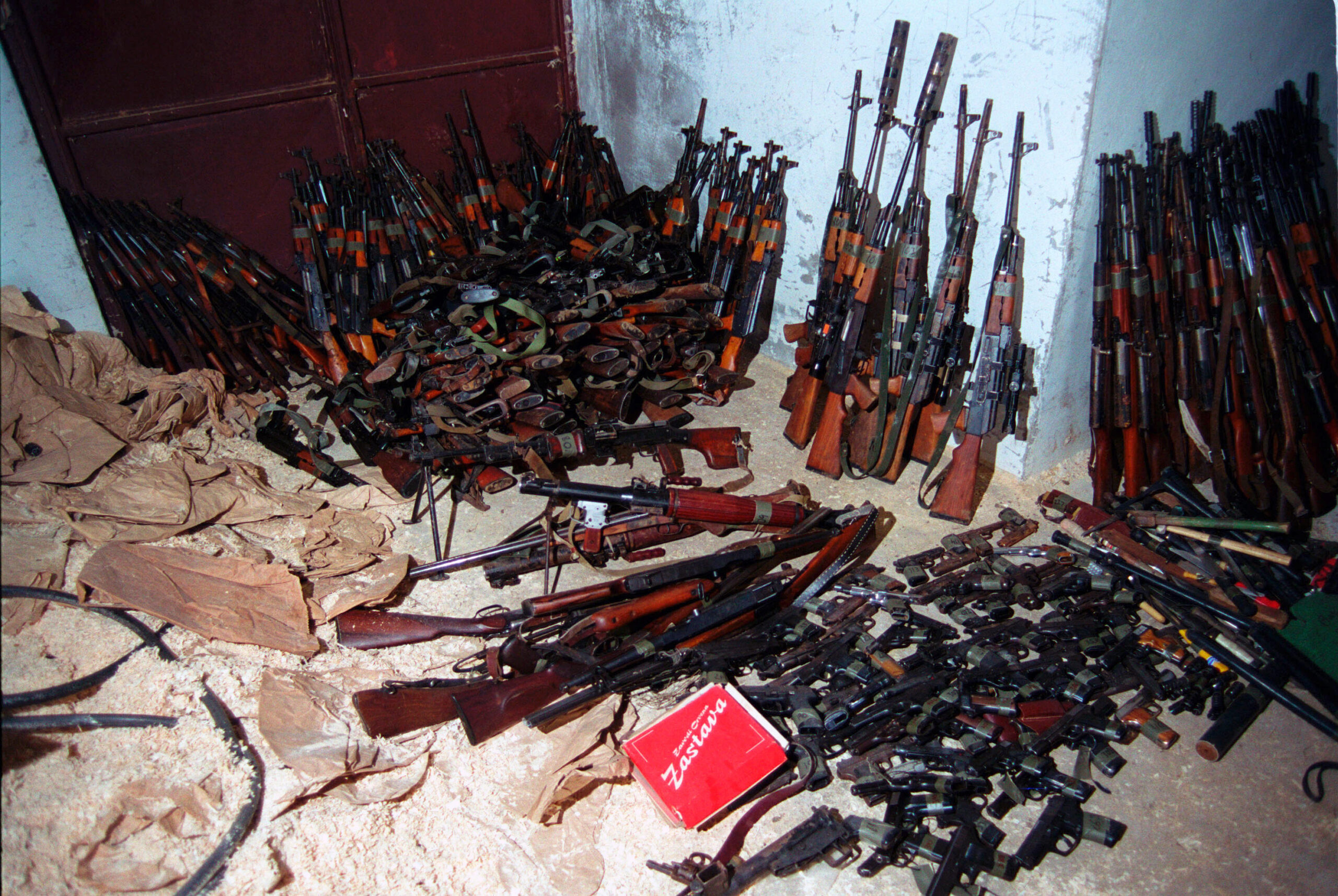
Weapons confiscated from the KLA, July 1999. (Craig J. Shell, U.S. Marine Corps, Public domain, Wikimedia Commons)
The British government was made aware of arms supplies to the KLA taking place near the Albanian border with Kosovo by at least June 1998.
The declassified files show that it was then that a confidential report was sent to Blair by Paddy Ashdown, a former special forces officer who then led the Liberal Democrats, following a visit to the Balkans.
Ashdown reported the Albanian view that arms were being transported to the KLA by the Albanian mafia. “Clandestine arms ‘supermarkets’” had been set up on the Albanian/Kosovo border “at which the KLA units and individuals on their way from abroad to join the KLA are able to purchase their needs,” he wrote
Ashdown also visited Bajram Curri and noted that Tropoje was “almost certainly the main center [sic]” for supplying arms to the KLA. Albania’s police authorities “are certainly turning a blind eye to what is happening,” he wrote.
Ashdown also wrote that the Albanian government “have evidence of Islamic attempts to infiltrate the KLA (especially from Iran) but believe this has been unsuccessful.”
Denials
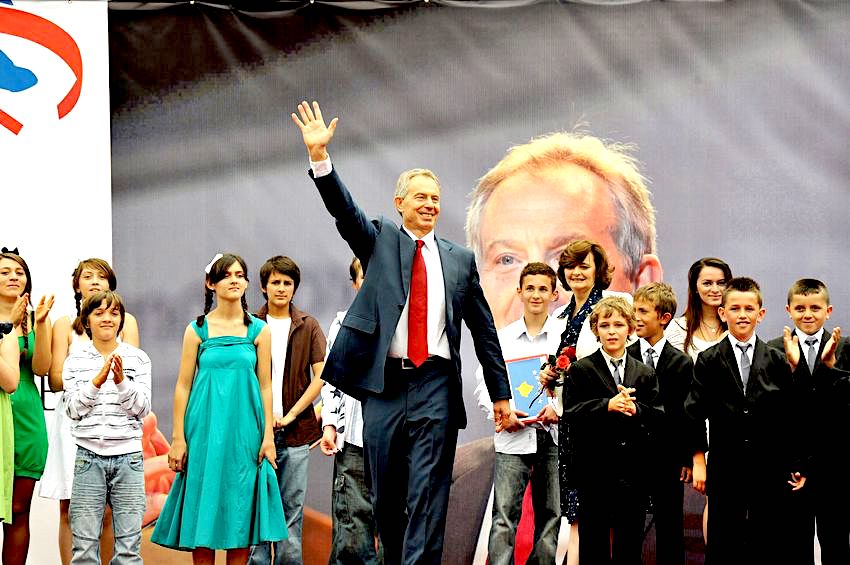
Former U.K. Prime Minister Tony Blair in Kosovo meeting children named after him, 2010. (Office of Prime Minister of Kosovo, Public domain, Wikimedia Commons)
The British training was kept secret. Ministers consistently denied any knowledge of the KLA’s sources of arms or training when asked in Parliament.
On 13 April 1999, three weeks after the NATO bombing campaign began, and just days before the Telegraph reported the British training, Tony Blair told parliament, “our position on training and arming the KLA remains as it has been — we are not in favour of doing so … We have no plans to change that.”
Sometimes ministers used revealing language. Baroness Symons stated on two occasions, in March and May 1999, that there was “no firm evidence” and “no reliable information” on the KLA’s sources of weapons and training. The use of the words “firm” and “reliable” is revealing, being a common method officials use to feign ignorance of issues they are aware of.
One reason for secrecy was that such training was in violation of U.N. Security Council Resolution 1160, which forbade arming or training forces in all Yugoslavia.
James Bissett, a former Canadian ambassador to Yugoslavia and Albania, later wrote that the U.S. training of the KLA in 1998 involved “sending them back into Kosovo to assassinate Serbian mayors, ambush Serbian policemen and intimidate hesitant Kosovo Albanians.”
“The hope”, he added, “was that with Kosovo in flames NATO could intervene and in so doing, not only overthrow Milosevic the Serbian strongman, but, more importantly, provide the aging and increasingly irrelevant military organisation [NATO] with a reason for its continued existence.”
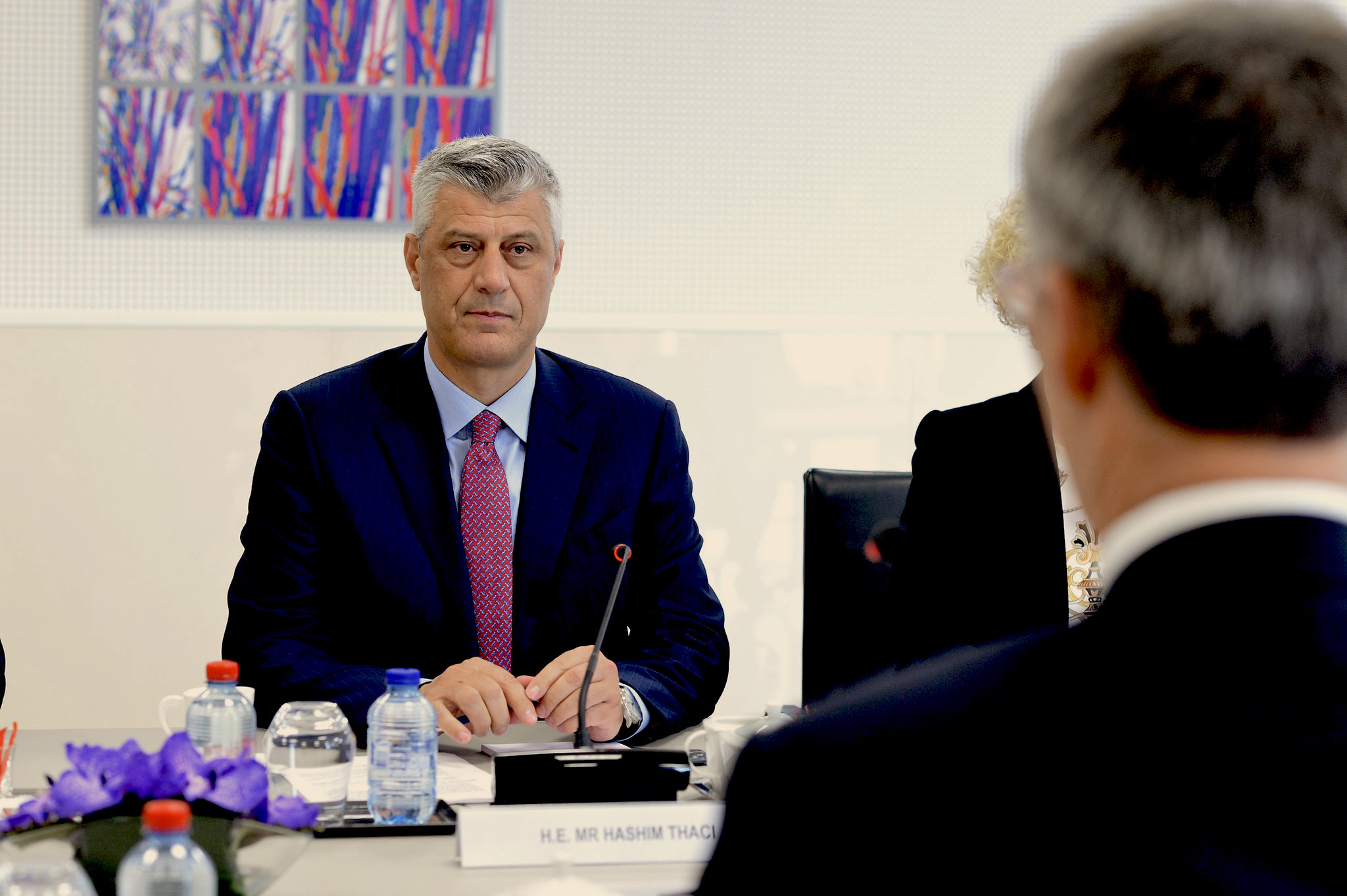
Kosovo’s Hashim Thaci meeting with NATO Secretary General Jens Stoltenberg, June 2016. (NATO)
KLA leader Hashim Thaci explained that “any armed action we undertook would bring retaliation against civilians [by Serbian forces]. We knew we were endangering a great number of civilian lives.”
‘Eyes & Ears’
The KLA certainly proved useful to Anglo–American planners. Blair stated a month into the NATO bombing campaign that “the KLA is having greater success on the ground in Kosovo and indeed has retaken certain parts of it.”
Described in media reports as NATO’s “eyes and ears” on the ground in Kosovo, the KLA was using satellite telephones to provide NATO with details of Serbian targets, according to reports in the British media.
Some of this communications equipment had been secretly handed over to the KLA a week before the air strikes began by U.S. officers acting as “ceasefire monitors” with the Organisation of Security and Cooperation in Europe. They were, in reality, C.I.A. agents.
They also gave the KLA U.S. military training manuals and field advice on fighting the Yugoslav army and police. The Sunday Times reported that several KLA leaders had the mobile phone number of General Wesley Clark, the NATO commander.

General Wesley Clark, Supreme Allied Commander of Europe, with soldiers deployed to Aviano Air Base, Italy, on May 9, 1999, in support of NATO Operation Allied Force. (U.S. Air Force/Public domain, Wikimedia Commons)
Robin Cook, meanwhile, held a joint press conference with KLA representatives at the end of March 1999 and was in direct telephone contact with its commander in Kosovo, Hashim Thaci, the British media reported.
Thaci was “rang up regularly” by Cook “to get information about what was happening in Kosovo,” Labour MP Alice Mahon told parliament later in 1999.
By May, The Independent was reporting that British and U.S. special forces have “gone on the offensive in Kosovo” and were working behind Serb lines “with the help of KLA men hand-picked from camps in northern Albania.”
It said that units of up of 20 to 30 Allied soldiers were working with up to 100 KLA men and quoted a senior KLA commander saying the U.K. and U.S. soldiers “either wore uniforms that could not be traced to any Allied unit or were disguised in the combat fatigues of the ‘Black Hand’ Serb paramilitaries.”
Soon after the bombing had begun, in early April 1999, more than 500 Albanians living in Britain volunteered to go to fight in Kosovo, according to KLA representatives in London, though they were likely exaggerating the numbers.
Just as during the Bosnian War a few years earlier, Britain and the U.S. allowed, and may have facilitated, British and other Muslims to travel to Kosovo volunteering for the jihad.
Macedonian Campaign
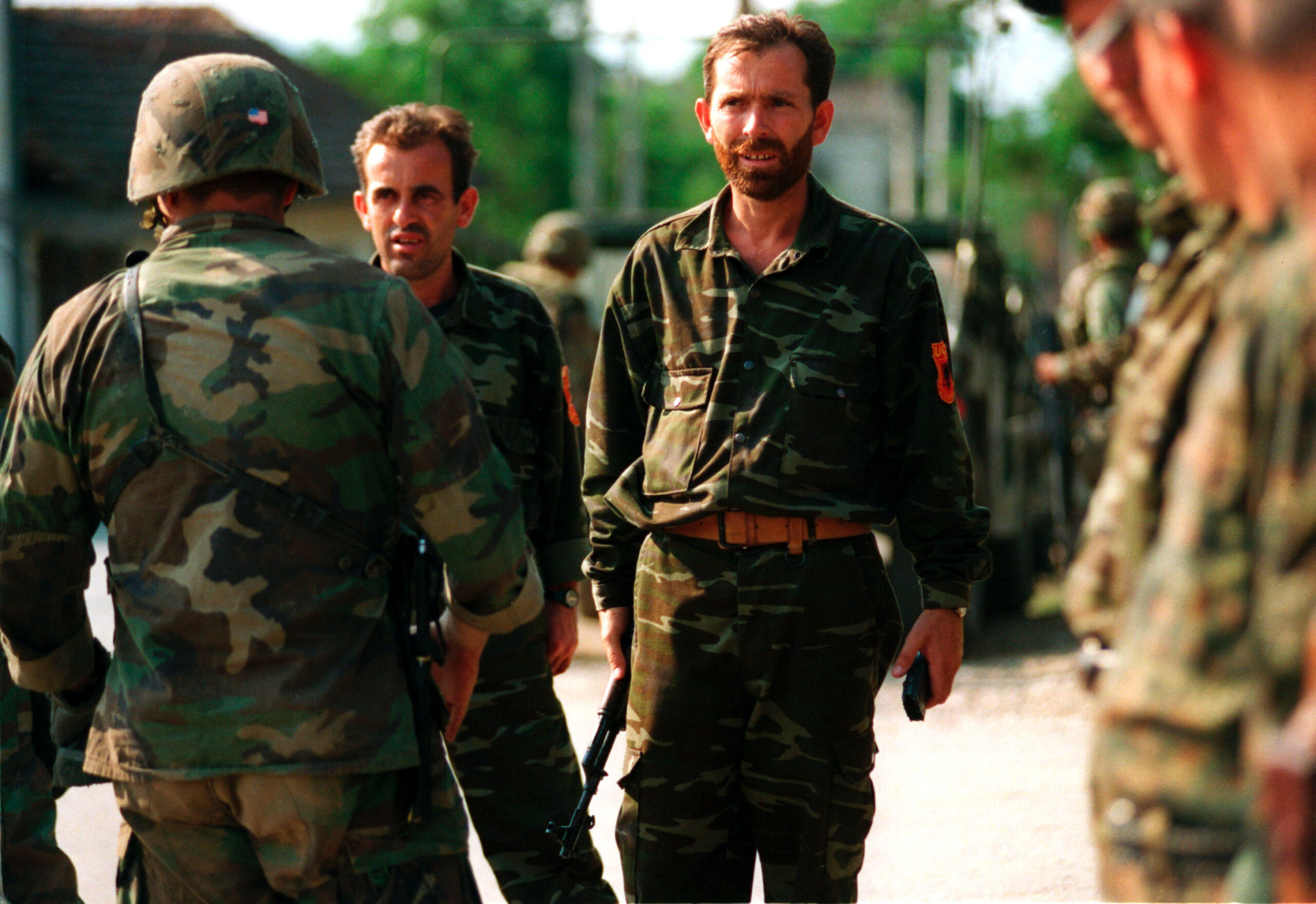
Members of the Kosovo Liberation Army turning over their weapons to U.S. Marines in the village of Zegra, Kosovo, June 30, 1999. (DoD/Craig J. Shell, Wikimedia Commons)
U.S. covert support of the KLA guerrillas did not stop when NATO’s Kosovo campaign was brought to an end in June 1999, or even with the fall of Milosevic in October 2000.
After the Kosovo conflict, KLA forces launched new wars in southern Serbia and Macedonia to promote their aim of a Greater Albania, both of which were initially supported by the US – but, not, apparently, by Britain.
In March 2001, KLA guerillas began to operate across Kosovo’s nearby border with Macedonia, led by several commanders previously trained by British forces for the Kosovo campaign.
Now fighting under the banner of the National Liberation Army (NLA), formed in early 2001, two of the Kosovo-based commanders of this push into Macedonia had been instructed by the SAS and the Parachute Regiment at the camps near Bajram Curri in northern Albania in 1998 and 1999.
One was organising the flow of arms and men into Macedonia, while the other was helping to coordinate the assault on the town of Tetevo in the north of the country near the border with Kosovo.
NLA forces were being called “terrorists” by Robin Cook and “murderous thugs” by NATO Secretary-General Lord Robertson, just as they had been before the March 1999 bombing campaign, when, as the KLA, the British were cooperating with them.
Arms supplies to the NLA from the U.S. helped the guerillas take control of nearly a third of Macedonia’s territory by August 2001. Soon, however, Washington, under pressure from its NATO allies, started to rein in its proxy force and throw its weight behind peace talks.
Thaci emerged from the diplomatic settlement to the Kosovo war as the leader of the strongest faction within the KLA and became Kosovo’s first prime minister. After elections in 2016, he became the territory’s president, resigning in 2020 after the war crimes charges were brought.
In addition to Thaci, also on trial in the Hague are Kadri Veseli, former head of the KLA’s intelligence service, Rexhep Selimi, head of the KLA’s operational directorate, and Jakup Krasniqi, a member of the KLA’s political directorate.
This is an updated, edited extract from Mark Curtis’ book, Secret Affairs: Britain’s Collusion with Radical Islam, where full references are provided.
Mark Curtis is the editor of Declassified UK, and the author of five books and many articles on U.K. foreign policy.
This article is from Declassified UK

Just as the UK/USA arm and train neo Nazi thugs in Ukraine….anything to destroy Russia, their obsession. I presume the historic links between Serbia/Yugoslavia and Russia were the reason for the USA making no effort to bring peace to Yugoslavia but rather did everything to break it up?
The needed prosecution is not of the KLA, but of Blair and his minions who empowered them to be what they were always known to be.
Back in the day, I was naive and I did not imagine how malign USA, UK, Germany could be. Now it is less surprising, but worth bringing to light, especially that it was a prelude to what happened and is still going in Ukraine. No “peaceful methods” exist for Russia, one can hope that the tide will turn.
But for that, people must know the methods of deep NATO structures. Natural naive thinking, as I had back than, is that the governments discussed here (and many other) have “good reasons” etc., and this is what bulk of NATO populations think (when they are not preoccupied in surviving on a job or finding cheaper toilet paper or gas station).
UK/US = the asses of evil. As someone put it not too long ago…’anglosaxon mania’
The bombing of Serbia in 1999 was based on deception and lies:
“The Rambouillet text, which called on Serbia to admit NATO troops throughout Yugoslavia, was a provocation, an excuse to start bombing. Rambouillet is not a document that an angelic Serb could have accepted. It was a terrible diplomatic document that should never have been presented in that form.”
—?Henry Kissinger, The Daily Telegraph, 28 June 1999
This was an excellent assessment and appraisal of what happened during those years. Tony Blair has always been a snake….a mere tool of the ruling folks who have run the UK since the days they purchased Winston Churchill’s soul in 1934.
TONY BLAIR SHOULD BE ROTTING IN JAIL FOREVER. HE IS A MASS-MURDERER.
Interesting. But hardly surprising. The evils of secrecy.